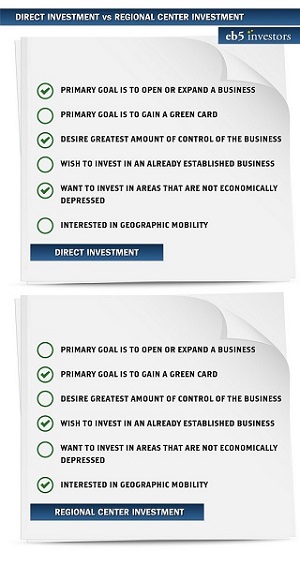
Updated By Elizabeth Krukova, Esq. and staff
Direct Investment vs. Regional Center Investment
The Immigrant Investor Program—also known as EB-5—is a visa program under which lawful permanent resident (LPR) status is granted to a foreign individual who invests a certain amount of capital in a new commercial enterprise. Investments may be made in either of two ways: 1) individually (direct), or 2) through a government-approved regional center.
Direct Investment Basics

In the direct method, the foreign individual invests directly in the enterprise rather than through an intermediary. Since March 2022, the minimum investment amount is $1.05 million, unless the enterprise is located in a targeted employment area (TEA), in which case the investment minimum is $800,000. A major distinguishing characteristic of the direct method is that, in filing the visa petition, investors must prove that their investment will directly (rather than indirectly) create full-time jobs for at least ten qualifying employees within two years of the visa petition’s approval. Direct jobs are those that are actual and identifiable (W-2 employees), and located within the investment-receiving enterprise. In addition to satisfying this job-creation requirement, direct investors must also meet several other legal requirements governing all (not only direct) EB-5 investors including, among others, the establishment of a “new commercial enterprise,” investor engagement in enterprise management, and if applicable, the enterprise’s location in a TEA.
Regional Center Basics
In the regional center method, the foreign individual invests in an enterprise through a government-approved regional center. The minimum investment amount is $1.05 million, or $800,000 if the investment project is located in a TEA. Most, but not all, regional centers are located in TEAs. Unlike a direct investor, a regional center investor can satisfy the job-creation requirement by creating direct or indirect full-time jobs for at least ten employees within two years of the visa petition’s approval. Indirect jobs are those created collaterally as a result of a regional center’s dispersal of investments to affiliated new commercial enterprises. Moreover, because a regional center is pre-approved by the government to promote economic growth, regional center investors generally will not have to conduct independent investigation and analysis to prove in the visa petition that the job-creation requirement has been met, that a new commercial enterprise has been established, or that the investor will engage in the management of the enterprise. Because most regional centers are also pre-approved by the government as being located in TEAs, the investor’s evidentiary burden is often further lightened if the reduced investment amount of $800,000 is desired.
Choosing an Investment Method
While the regional center method may be less burdensome in many respects, it may not appeal to every EB-5 investor. If individuals want to start their own business or expand a preexisting one, and therefore seek greater control of their investment and company operations, the direct method may be the better option. Indeed, the necessity to obtain permanent residency through direct investment may simply be incidental to a foreign entrepreneur’s primary objective of expanding business operations to the United States. Also, because business ventures will tend to have a higher chance of success in regions with better economic conditions, investors seeking to maximize profits may find more options by investing directly rather than in a regional center, most of which are located in TEAs. Furthermore, greater business control may facilitate easier collection of evidence to prove the satisfaction of legal requirements, thereby assuaging, to some degree, the evidentiary burden of direct investors. Nevertheless, a strong business motivation alone is insufficient to make the direct method a good option, as other factors must be considered. Most importantly, the investor must consider the feasibility of creating actual, identifiable full-time jobs within the enterprise for at least ten qualifying employees.
At the other end, the indirectness of the regional center method may appeal to investors who are less business-driven. Regional center investors can take advantage of established, government-approved economic units rather than expending time and energy to build their own enterprise. Moreover, in addition to carrying a lighter evidentiary burden, regional center investors who obtain permanent residency will also have more geographic mobility both within and outside of the United States since they are not tethered to the location of the commercial enterprise as are direct investors who are more directly involved with their investment. However, investing through the intermediary of a regional center does not eliminate the importance of due diligence. Individuals interested in regional center investment will want to consider the qualifications of available regional centers and their affiliated enterprises, including information about government approval, investment experience, success in job creation, financial outlook, and visa petition approval rates.
What All EB-5 Investors Should Keep in Mind
All foreign individuals considering the EB-5 program should consult an immigration attorney to choose the investment method best tailored to their circumstances. They should ask questions about issues including, but not limited to, those discussed in the previous paragraphs so that the relevant features of an individual’s situation can be taken into account when deciding the proper investment method, and the suitability of the EB-5 program in general.






